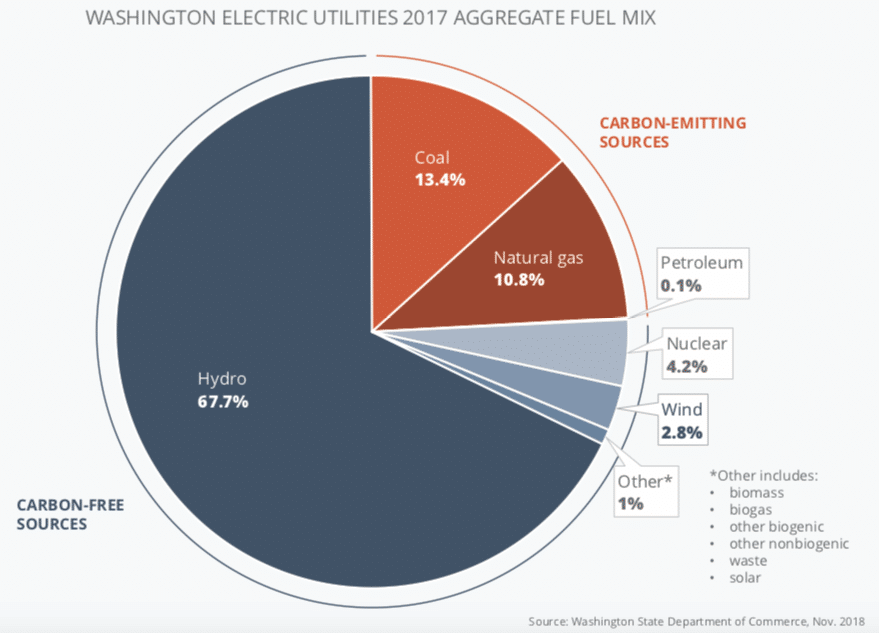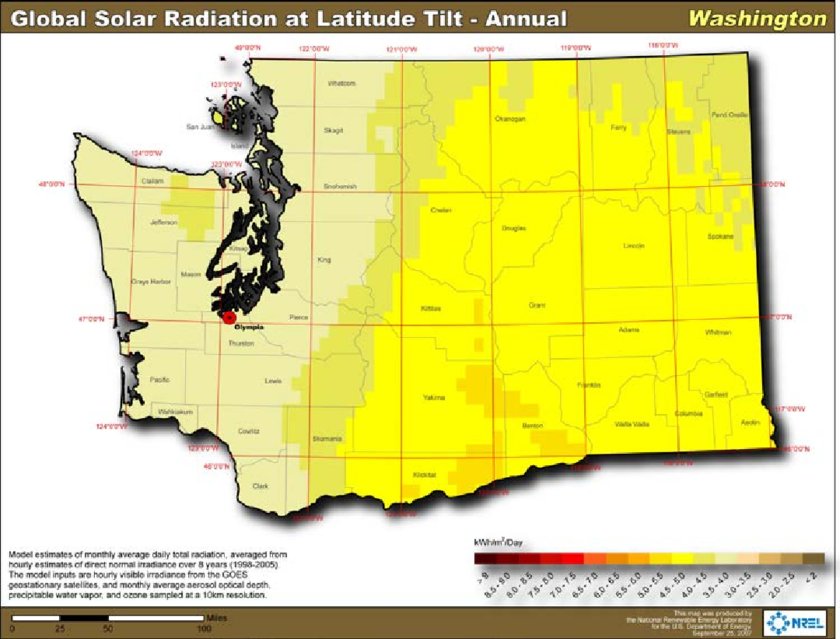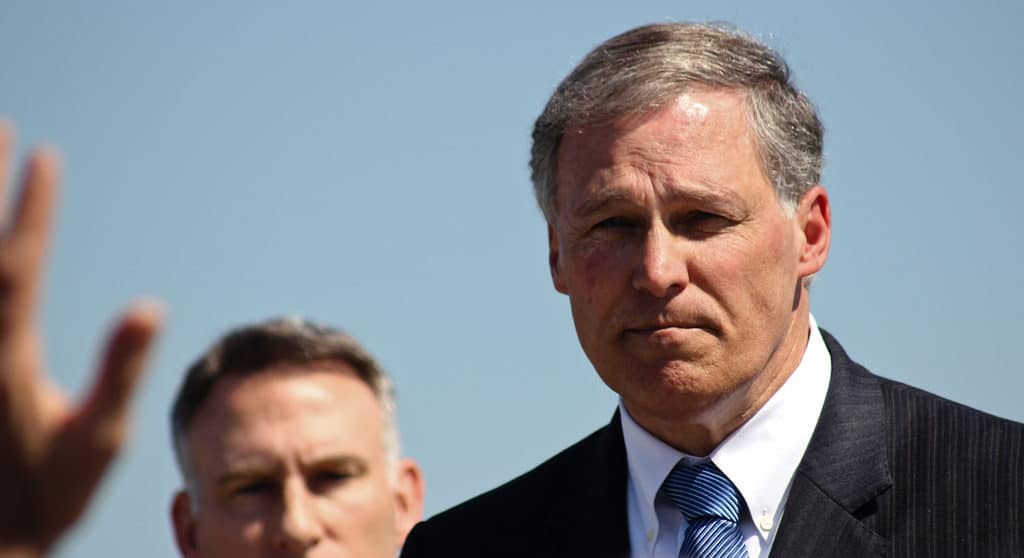On Monday Washington Governor Jay Inslee (D) announced a clean energy proposal to move his state to a “carbon-neutral” electricity supply by 2030, and 100% clean electricity by 2045. This is part of a range of reforms aimed at reducing greenhouse gas emissions 25% below 1990 levels by 2035, and is expected to be introduced as a package of bills when the legislature reconvenes in January.
These two goals appear on the surface somewhat redundant, the exact definitions of “carbon-neutral” and “clean” were not given in the documents accompanying the announcement.
The proposal has an emphasis on eliminating coal in the state’s electricity supply, and a fact sheet notes that the legislation will eliminate imports of coal by 2025 – the same year that the state’s final coal plant is scheduled to retire. Coal met 13% of Washington’s electricity demand in 2017.
Clean energy standard, incentives and more
While only a summary of the proposed mechanisms to reach these targets was provided, the legislation appears to set up a clean energy standard, similar to the one passed in California, whereby utilities must entirely eliminate fossil fuels in their electricity supply by 2045.
There are a number of other proposals included in what is described as complementary legislation. This includes:
- 10-year extension of the sales and use tax incentive for renewable energy machinery and equipment
- reform of the energy siting process, including modifying the composition of the state’s board and streamlining review of certain projects
- expanding funding for the state’s solar energy production initiative
As part of the policy package, Governor Inslee is planning the following investments through his budget proposal:
- $22 million in grid modernization
- $18 million in strategic R&D for new and emerging clean energy technologies
- $12 million to non-profit energy efficiency and renewable energy lenders
- $6 million to the sate’s solar incentive program
Opportunities for solar
And as Washington already gets 2/3 of its electricity from hydro – the largest portion of any state – the state’s electricity portfolio is already remarkably clean and the task of decarbonizing electricity will be much easier than in other states. But there are still opportunities for both wind, particularly given the potential along the Columbia River Valley, and solar.

Washington has built very little solar to date. According to Solar Energy Industries Association (SEIA), the state had installed 133 MW through the second quarter of this year, putting it 31st for installed capacity to date. The large majority of this is residential systems, however in October Swinerton and Strata Solar put online a 28 MW project, the largest in the state to date.
This relative lack of development in Washington is not due to lack of resources. While most of the population of the state is in Seattle and surrounding cities in the rainy and cloudy Western third of Washington, the relatively arid lands east of the Cascade Mountains provide much better solar potential, and this is where large-scale solar development is beginning to take off.

As such, there may be a significant market for solar of all scales in the state. Additionally the task of integrating higher levels of solar and wind may be easier than in other states, given Washington’s abundance of hydropower. In both Scandinavia and Costa Rica, hydropower has been successfully used to help the variable output of wind match the patterns of electricity demand.
The nuclear question
Another open question in the legislation is the role of the 1.1 GW Columbia Generating Station, the Pacific Northwest’s sole remaining nuclear power plant and one of only two in operation on the West Coast. As the plant went online in 1984, it is one of the newest in the U.S. nuclear fleet, and it is possible that its output – which comprised 4% of the state’s electricity – will be included in the definition of “clean”.
Nuclear appeared nowhere in the accompanying documents, so until the legislation is filed, it may be difficult to know these details.
Cleaning transportation?
While the changes to the electricity supply are expected to deliver the largest single portion of reductions, the plan also includes a proposal to clean transportation emissions. This includes a clean fuel standard similar to that in Oregon, California and British Columbia.
But while electric vehicles are also mentioned, details are sparse, stating merely that the proposal will “build upon current efforts to promote electric vehicles and ferries and ensures electric and zero-emission vehicle options are a more affordable and convenient option for consumers across the state.
Governor Inslee’s proposal can also be seen in light of the recent spectacular failure of the third attempts to tax carbon in the state. On November 6th voters rejected a tax of $15 per ton on carbon by 56%-43%, following massive spending by the oil and gas industry.
Proposals to decarbonize electricity have had much greater success than carbon taxes, and in particular this proposal is much less likely to run into opposition from the oil industry, given that it has a lighter touch on transportation fuel, which is by far the largest source of demand for petroleum.
But it could also be kicking the can down the road to some degree, as transportation represents the largest source of greenhouse gas emissions in Washington State and nationally.
This content is protected by copyright and may not be reused. If you want to cooperate with us and would like to reuse some of our content, please contact: editors@pv-magazine.com.









By submitting this form you agree to pv magazine using your data for the purposes of publishing your comment.
Your personal data will only be disclosed or otherwise transmitted to third parties for the purposes of spam filtering or if this is necessary for technical maintenance of the website. Any other transfer to third parties will not take place unless this is justified on the basis of applicable data protection regulations or if pv magazine is legally obliged to do so.
You may revoke this consent at any time with effect for the future, in which case your personal data will be deleted immediately. Otherwise, your data will be deleted if pv magazine has processed your request or the purpose of data storage is fulfilled.
Further information on data privacy can be found in our Data Protection Policy.